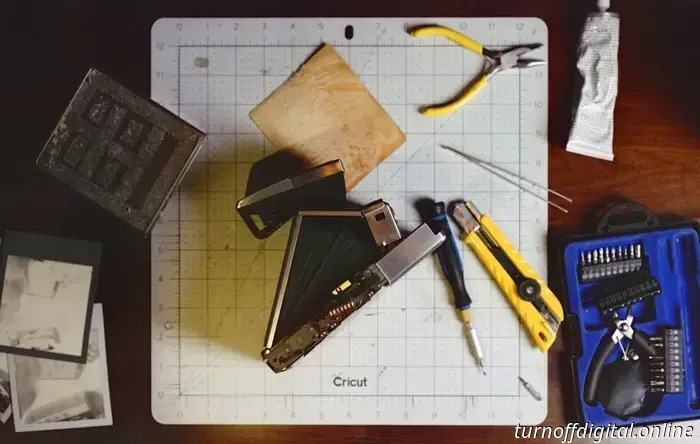
Analog.Cafe › Guides and Tutorials › 11 min read by Dmitri. Published on August 12, 2025. The Polaroid SX-70 is regarded as the most advanced instant film camera ever created. Although these cameras were manufactured in the 1970s, their comprehensive features remain unrivaled today. Currently, SX-70 cameras can be found for under $100. However, repair costs can be quite high. Some refurbished models are priced over $1,000, and typical repair services can cost several hundred dollars, including shipping, long wait times, and tax fees. I purchased my SX-70 for less than $20 at a thrift store six years ago, and it has met all my Polaroid film needs ever since. Various new Polaroid cameras have come and gone; I have even bought and sold other SX-70 cameras, but my first one remains my favorite and most affordable instant film camera. The model I own is Model 1, the first major production run after the Alpha versions, featuring real leather. As a result, it is approximately 55 years old. SX-70 cameras are similar to film point-and-shoots, filled with electronics and fragile plastic parts; despite being well manufactured, issues can arise. A common problem is a malfunctioning or "sticky" film ejection mechanism. This may present as the camera making the ejection sound but not dispensing the frame. This article provides relatively simple, illustrated instructions for diagnosing the issue and two separate repair tips for fixing the malfunctioning ejection mechanism at home. If you've read the "Home Film Camera Maintenance and Basic Repair Guide," you should possess the fundamental knowledge needed to undertake these repairs. In this guide: Some repair experience may be beneficial. Tools and materials. Potential causes of film ejection failure on an SX-70. Disassembly: taking off the bottom plate. Disassembly: detaching the film door and rollers. Repairing the damaged motor coupler. Lubricating the spring-loaded arm. Testing and reassembly. Support this blog and access premium features with GOLD memberships! Some repair experience may be helpful. If your SX-70 holds the same significance for you as it does for me, you may feel hesitant to delve into the inner workings of a complicated vintage camera. This apprehension is completely understandable. The repairs detailed in this guide should be manageable for anyone with steady hands and some experience using small repair tools or even LEGOs. The most challenging part of this guide involves stretching a spring and affixing it onto a round metal peg using small pliers. Should you break the spring, finding a replacement might prove difficult. Removing the leatherette cover can also be tricky, as it may have a layer of metal and strong adhesive—exercise caution to avoid tearing the leather. If you're not yet ready to attempt these repairs but are interested in trying in the future, I recommend acquiring a non-functioning camera and the tools mentioned in this article to familiarize yourself with assembly and disassembly (seek out cameras that have good repair guides available online). This article will assist you in getting started with DIY repairs at home. Tools and materials. To diagnose and repair your SX-70’s film ejection mechanism, you will require: - A well-lit working area, - A self-healing mat, - A set of microscrewdrivers (compatible with Torx T4 screws), - Tweezers and small pliers, - A tube of lubricating oil, - A tube of E6000 glue or double-sided tape for reattaching the leatherette, - A bottle of 95-99% rubbing alcohol, - Cotton swabs and other cleaning tools, - Gloves, - An empty SX-70 or 600 film cartridge, - A few exposed or damaged frames of film you are willing to use for testing the camera, - A replacement leatherette, as your SX-70 may use material prone to scratching and flaking off, which could disintegrate during disassembly; reskinning your camera can help it look fresh and appealing. A view of Polaroid SX-70's mechanical drive assembly. What could lead to film ejection failure in an SX-70? The Polaroid SX-70 is a complex device comprising numerous components that are over fifty years old. Film ejection failures are solely mechanical issues that can happen anywhere along the motors and gears driving the mirror, film ejection arm, and rollers. When these cameras were first released, their mechanical forces were balanced according to the materials used in the components. For instance, a metal shaft would withstand greater forces than a plastic gear. Unfortunately, plastics age relatively quickly, meaning a small plastic part linked to a motor drive is often the primary suspect if your camera fails to eject film. Hardened lubricants and debris are common problems in all vintage mechanical cameras, and the SX-70 is no exception. Thus, the second likely reason for film ejection failures is friction
This article provides straightforward, illustrated guides for diagnosing and two distinct repair suggestions to address the malfunctioning ejection mechanism on Polaroid SX-70 cameras at home. It includes numerous detailed photos, close-ups, and instructions for testing the repairs to ensure dependable operation for years ahead.